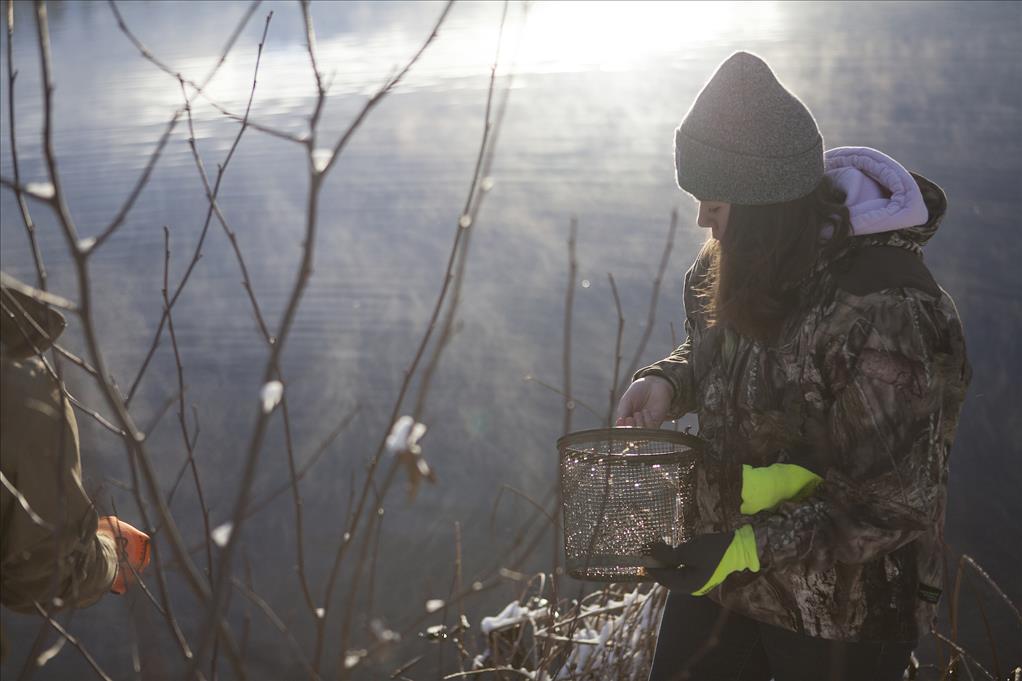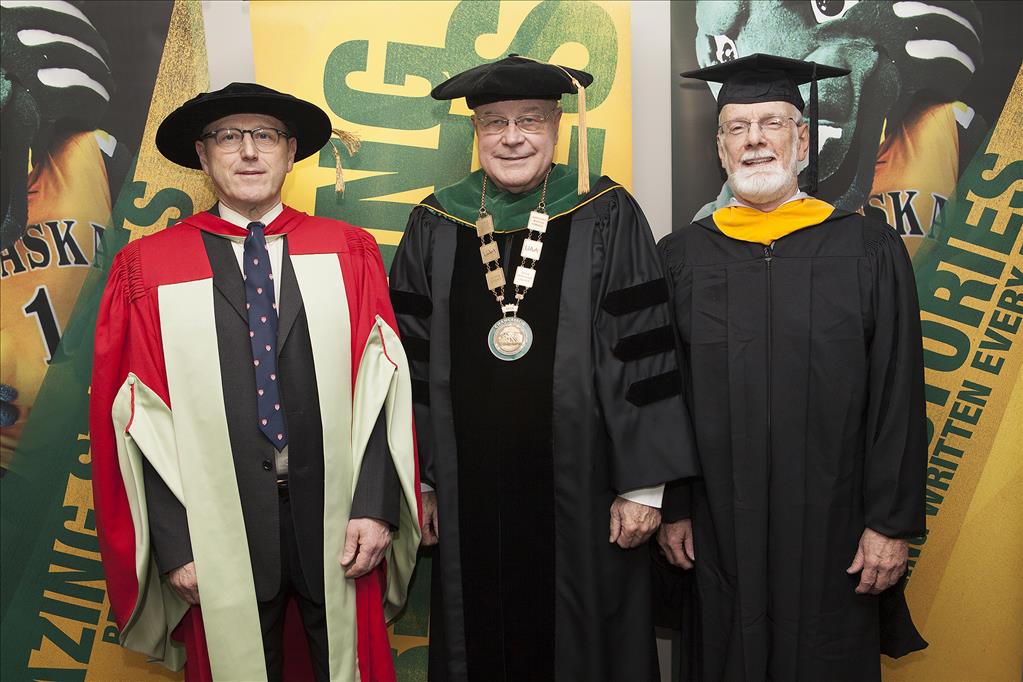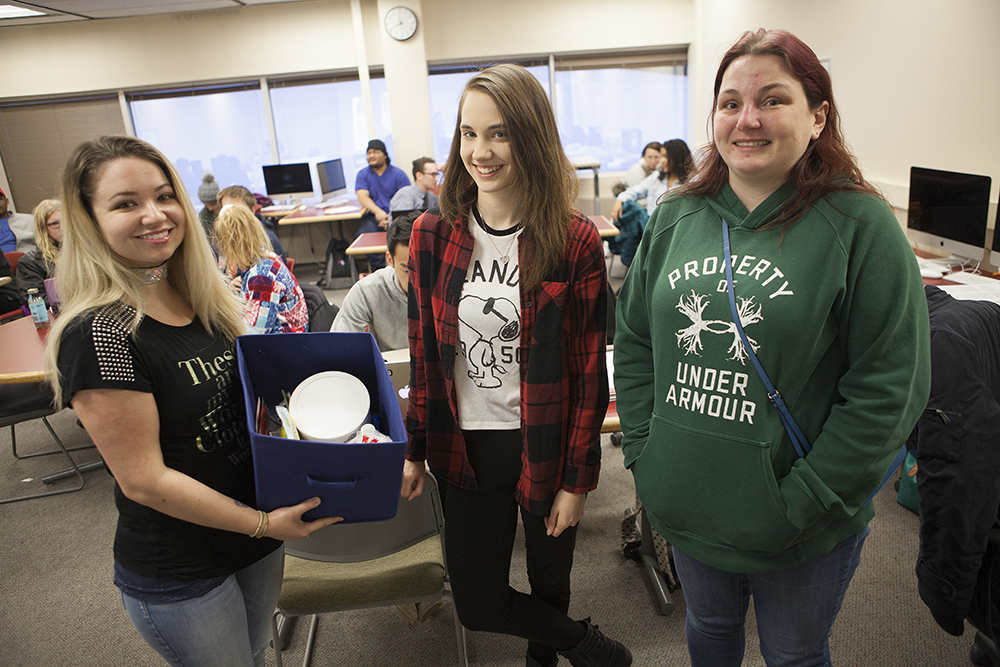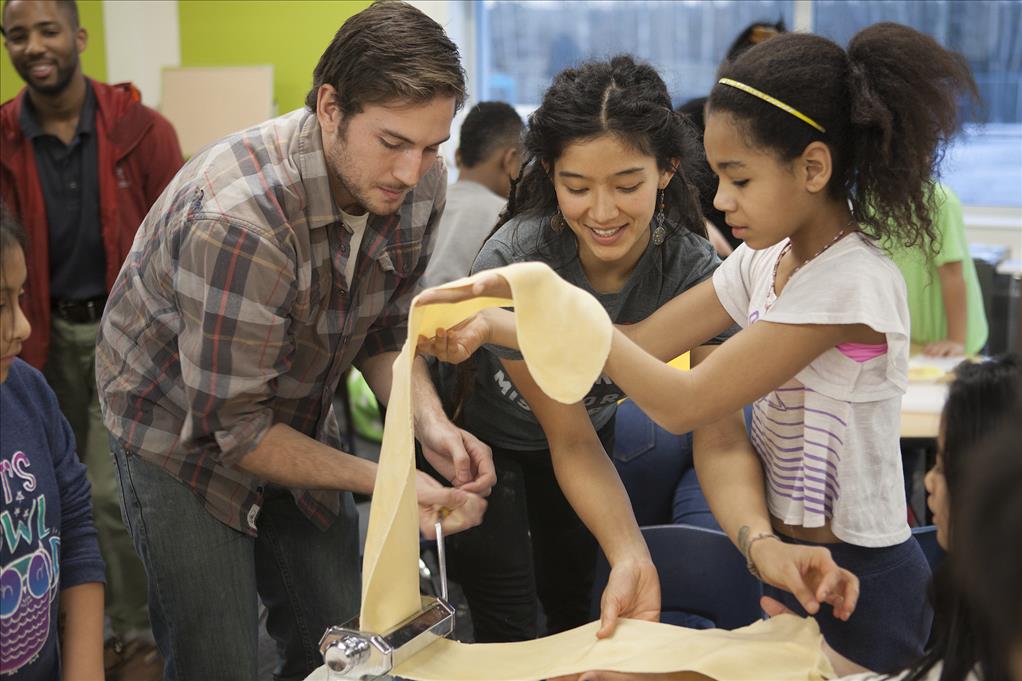Geomatics is a day at the beach for #UAAgrad
by J. Besl |

I AM UAA: Graduating senior David Parret built an augmented reality sandbox, at left, to increase the visibility of the geomatics department. (Photo by Phil Hall / University of Alaska Anchorage)
Geomatics is such a foreign concept to most people, even Microsoft's spellcheck tool doesn't recognize the word. But the field has defined centuries of history, and will continue to push (and define) boundaries in the future.
So what falls under geomatics? Land surveying, for one, and all the ancient Romans and Egyptians who first used math to divvy up their empires. Then there's mapping, and all the explorers and renaissance artists who plied the seas and painted those canvases. More recently, there's GIS (geographic information systems), and the modern-day wizards behind GoogleMaps, satellite imagery and self-driving cars. Geomatics is everyone from Da Vinci to Lewis and Clark to Elon Musk. So why don't more people recognize the career path today?
Graduating senior David Parret has an eye-catching solution for his department's visibility, and he has personal motivation as well. For over a decade, he took classes at UAA waiting for something to click. The problem — he just hadn't heard of geomatics.
Since discovering the department and declaring a major, he's been dedicated to spreading the word in Alaska (which, it should be noted, is the only state in the nation that still hasn't been fully mapped). He found the best way to get people's attention, of course, was through bright colorful lights. And a sandbox.
The roadmap to geomatics
For David, Commencement on May 1 concludes 15 years of on-and-off study at UAA.
After graduating from Service High School, David enrolled at UAA alongside his high school sweetheart — now his wife, Ginny Cress Parret. Ginny took to college immediately, becoming one of the first students to receive her bachelor's, master's and Ph.D. from UAA (through a joint doctoral program with UAF). But David was a different story. He enrolled in the general courses, hoping something would connect. But nothing did.
After a few listless semesters, he went to work in construction and put his education to the side. "I knew that I wanted to be a college graduate, but I wasn't willing to settle for just any degree," he noted. "I wanted it to be something that I had a passion for, would challenge me and in the end and land me a job."
In 2012, he was downtown with his father-in-law Bob Cress when a hubbub at the Hilton caught their eye. It was the annual Alaska Surveying & Mapping Conference, and they decided to step inside. They stopped by the Geomatics Student Association, where his father-in-law signed David up for a department tour. "I'd never heard of geomatics," David admitted, but thankfully things finally clicked.
Though he'd occasionally enrolled in online classes from time to time, David hadn't been a full-time student in nearly a decade. With so many general classes already out of the way, David finished his geomatics requirements and several levels of math in only seven semesters. Along the way, he joined the Geomatics Student Association and worked to prioritize outreach so potential majors had an easier time finding their home in the College of Engineering.
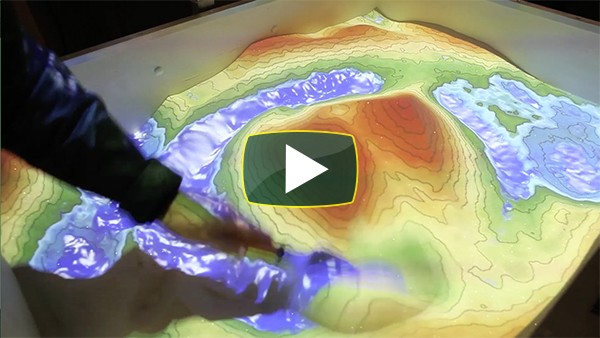
The augmented reality sandbox uses an Xbox Kinect camera to capture the topography of the sand below. A Linux computer then processes the data and quickly projects bright colors and topographic lines below. Shadows over the display are interpreted as rain clouds, sending digital rain splashing down the hills and canyons in the sandbox. (Video by Phil Hall / University of Alaska Anchorage)
Bright lights, big topography
Though geomatics is hands-on, the tools of the trade — tripods, satellite receivers, etc. — just aren't as eye-catching as the Baja cars and rockets on display from other departments. So he built an augmented reality sandbox as an outreach effort.
"Its like a big old neon light," he said of the project, which he spent last summer building. "It really sucks people in and gives us the opportunity to get people's ears."
The sandbox, which demonstrates responsive topographic maps in 3-D, is built of three main tech components — a projector, a computer and a sensor camera. The computer program comes from Dr. Oliver Kreylos, a scientist at UC-Davis who posted his technology online for public use. "He's an absolute genius," David noted.
But that's the boring backend stuff. Let's talk about that sand.
The sand is glorious — fine white crystals that run through your fingers and make you want to grab a piña colada. Even the name of the sand supplier — Sandtastic — evokes a giddy sense of fun. Its silica-free, safe for kids, light, reflective and there's 200 pounds of it sitting in the sandbox. Though the shipping was free (thanks, Amazon Prime!), "I felt sorry for my mailman," David joked.
At the digital sandbox, you can pile sand into mountains, carve out craters, build and break dams and cause a deluge with the wave of a hand. So much power!
Once the camera — in this case, repurposed from an Xbox Kinect — records the sand below, the projector quickly splashes down colorful topographic lines to illuminate the elevation of your creation. Want to make a lake? Just build the banks and hold your hand over the sandbox; your shadow becomes a rain cloud, dumping rich blue water (digitally) into the display.
"People of all ages — from 2 to as old as you can imagine — just love this thing," David said of the sandbox. He debuted his creation at Campus Kick-Off in the fall, and it's certainly accomplished its goal. Area science teachers now beg David to bring the sandbox to their school and talk about geomatics. But because it's bulky and complex, it's so far been easier for students to visit campus and tour the Engineering & Industry Building instead.
Leaving the sandbox
Now, though, it's time to shake off the sand and graduate. "It's pretty surreal," he said, reflecting on the geomatics department. "We're a small program. I've had the same classes with the same students the whole time, so we're a tightknit family here, and all our professors are pretty awesome. I'm going to miss coming in and bouncing ideas off them," he noted, pausing. "I felt that way until about a week ago. Now I'm ready to be done," he laughed.
He credits the department for connecting him with resources, employers and job opportunities. "There's a chance [in other departments] you could graduate and never meet someone who's doing what you want to do," he noted, but not in geomatics.
He's optimistic about the future. And why not? "We have more work than we have students," David said, noting that so many employers talked to the Geomatics Student Association at conferences that they ended up just putting everyone's résumés together in a binder. The digital sandbox was designed to be an eye-catching recruitment tool for the department, but it's likely to be an even more eye-catching line on David's résumé.
After watching his wife graduate three times from UAA, it's time to turn the table. Ginny will be in the stands with their nearly two-year-old son on May 1 as David crosses the stage for his diploma.
And though the family is happy he's finally earning his degree, they're also looking forward to having a lot less sand inadvertently dragged into the house.
Click here to read more stories from the geomatics department.
 "Geomatics is a day at the beach for #UAAgrad" is licensed under a Creative Commons Attribution-NonCommercial 4.0 International License.
"Geomatics is a day at the beach for #UAAgrad" is licensed under a Creative Commons Attribution-NonCommercial 4.0 International License.










